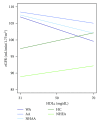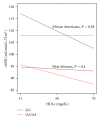Variation in APOL1 Contributes to Ancestry-Level Differences in HDLc-Kidney Function Association
- PMID: 22973513
- PMCID: PMC3438781
- DOI: 10.1155/2012/748984
Variation in APOL1 Contributes to Ancestry-Level Differences in HDLc-Kidney Function Association
Abstract
Low levels of high-density cholesterol (HDLc) accompany chronic kidney disease, but the association between HDLc and the estimated glomerular filtration rate (eGFR) in the general population is unclear. We investigated the HDLc-eGFR association in nondiabetic Han Chinese (HC, n = 1100), West Africans (WA, n = 1497), and African Americans (AA, n = 1539). There were significant differences by ancestry: HDLc was positively associated with eGFR in HC (β = 0.13, P < 0.0001), but negatively associated among African ancestry populations (WA: -0.19, P < 0.0001; AA: -0.09, P = 0.02). These differences were also seen in nationally-representative NHANES data (among European Americans: 0.09, P = 0.005; among African Americans -0.14, P = 0.03). To further explore the findings in African ancestry populations, we investigated the role of an African ancestry-specific nephropathy risk variant, rs73885319, in the gene encoding HDL-associated APOL1. Among AA, an inverse HDLc-eGFR association was observed only with the risk genotype (-0.38 versus 0.001; P = 0.03). This interaction was not seen in WA. In summary, counter to expectation, an inverse HDLc-eGFR association was observed among those of African ancestry. Given the APOL1 × HDLc interaction among AA, genetic factors may contribute to this paradoxical association. Notably, these findings suggest that the unexplained mechanism by which APOL1 affects kidney-disease risk may involve HDLc.
Figures



Similar articles
-
APOL1 G1 genotype modifies the association between HDLC and kidney function in African Americans.BMC Genomics. 2015 May 30;16(1):421. doi: 10.1186/s12864-015-1645-7. BMC Genomics. 2015. PMID: 26025194 Free PMC article.
-
Gene-based sequencing identifies lipid-influencing variants with ethnicity-specific effects in African Americans.PLoS Genet. 2014 Mar 6;10(3):e1004190. doi: 10.1371/journal.pgen.1004190. eCollection 2014 Mar. PLoS Genet. 2014. PMID: 24603370 Free PMC article.
-
Effect of Genetic African Ancestry on eGFR and Kidney Disease.J Am Soc Nephrol. 2015 Jul;26(7):1682-92. doi: 10.1681/ASN.2014050474. Epub 2014 Oct 27. J Am Soc Nephrol. 2015. PMID: 25349204 Free PMC article.
-
Association Between APOL1 Genotype and Kidney Diseases and Annual Kidney Function Change: A Systematic Review and Meta-Analysis of the Prospective Studies.Int J Nephrol Renovasc Dis. 2021 Apr 7;14:97-104. doi: 10.2147/IJNRD.S294191. eCollection 2021. Int J Nephrol Renovasc Dis. 2021. PMID: 33854359 Free PMC article. Review.
-
Target organ damage in African American hypertension: role of APOL1.Curr Hypertens Rep. 2012 Feb;14(1):21-8. doi: 10.1007/s11906-011-0237-4. Curr Hypertens Rep. 2012. PMID: 22068337 Free PMC article. Review.
Cited by
-
APOL1 Kidney Disease Risk Variants: An Evolving Landscape.Semin Nephrol. 2015 May;35(3):222-36. doi: 10.1016/j.semnephrol.2015.04.008. Semin Nephrol. 2015. PMID: 26215860 Free PMC article. Review.
-
The Apolipoprotein L1 Gene and Cardiovascular Disease.Methodist Debakey Cardiovasc J. 2016 Oct-Dec;12(4 Suppl):2-5. doi: 10.14797/mdcj-12-4s1-2. Methodist Debakey Cardiovasc J. 2016. PMID: 28298955 Free PMC article. Review.
-
Variant APOL1 protein in plasma associates with larger particles in humans and mouse models of kidney injury.PLoS One. 2022 Oct 24;17(10):e0276649. doi: 10.1371/journal.pone.0276649. eCollection 2022. PLoS One. 2022. PMID: 36279295 Free PMC article.
-
Serum HDL-C level of Iranian adults: results from sixth national Surveillance of Risk Factors of Non-Communicable Disease.J Diabetes Metab Disord. 2014 Jun 16;13:67. doi: 10.1186/2251-6581-13-67. eCollection 2014. J Diabetes Metab Disord. 2014. PMID: 25028645 Free PMC article.
-
Evolution of the primate trypanolytic factor APOL1.Proc Natl Acad Sci U S A. 2014 May 20;111(20):E2130-9. doi: 10.1073/pnas.1400699111. Epub 2014 May 7. Proc Natl Acad Sci U S A. 2014. PMID: 24808134 Free PMC article.
References
-
- Attman PO, Samuelsson O. Dyslipidemia of kidney disease. Current Opinion in Lipidology . 2009;20(4):293–299. - PubMed
-
- Trevisan R, Dodesini AR, Lepore G. Lipids and renal disease. Journal of the American Society of Nephrology . 2006;17(supplement 2):S145–S147. - PubMed
-
- Schlondorff D. Cellular mechanisms of lipid injury in the glomerulus. American Journal of Kidney Diseases . 1993;22(1):72–82. - PubMed
-
- Abrass CK. Cellular lipid metabolism and the role of lipids in progressive renal disease. American Journal of Nephrology . 2004;24(1):46–53. - PubMed
-
- Dalrymple LS, Kaysen GA. The effect of lipoproteins on the development and progression of renal disease. American Journal of Nephrology . 2008;28(5):723–731. - PubMed
Grants and funding
LinkOut - more resources
Full Text Sources
Other Literature Sources
Research Materials
Miscellaneous

